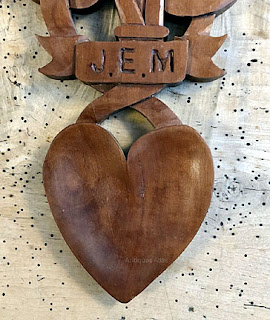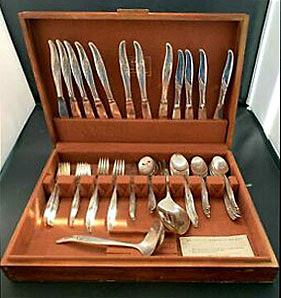 QUESTION: I have inherited a chest that originally belonged to my great-grandmother which had been passed down to her daughter, my grandmother, then to my mother, her daughter. My mother used the chest, made of cedar, to store blankets and linens in her bedroom. I inherited it when she died two years ago. People have told me that it was a hope chest. What was a hope chest and what was it used for?
QUESTION: I have inherited a chest that originally belonged to my great-grandmother which had been passed down to her daughter, my grandmother, then to my mother, her daughter. My mother used the chest, made of cedar, to store blankets and linens in her bedroom. I inherited it when she died two years ago. People have told me that it was a hope chest. What was a hope chest and what was it used for?
ANSWER: “A rose by any other name....” so go the words of William Shakespeare. The same can be said of the “hope” chest. Originally referred to as a dowry chest, cedar chest, or trousseau chest, it changed names with the times. The dowry chest was meant to contain assets–money and jewelry—that the family of the bride gave to the groom in exchange for their daughter’s hand in marriage. But hope chest implies something else—the hope for a good life for her in marriage.
 Young unmarried women used a hope chest to collect and store items, such as clothing and household linen, in preparation for married life. Americans called this a "hope chest" or "cedar chest" while the British referred to it as a "bottom drawer."
Young unmarried women used a hope chest to collect and store items, such as clothing and household linen, in preparation for married life. Americans called this a "hope chest" or "cedar chest" while the British referred to it as a "bottom drawer."
 What did a young girl put in her hope chest? Typically, she stored traditional dowry items, such as special dresses, table linens, towels, bed linens, quilts, silverware, and sometimes kitchen items. As a bride would normally leave home when she married, cabinetmakers often made hope chests to be portable by including sturdy handles on either side.
What did a young girl put in her hope chest? Typically, she stored traditional dowry items, such as special dresses, table linens, towels, bed linens, quilts, silverware, and sometimes kitchen items. As a bride would normally leave home when she married, cabinetmakers often made hope chests to be portable by including sturdy handles on either side.
Traditionally, a mother would pass her hope chest down to her daughter. She would start preparing a hope chest from the time her daughter was a young age and slowly build the collection as the years went by. The chests contained many things thought of as “essentials,” such as china, silverware, linens, clothing, and jewelry, that a young woman would need to start a new life in marriage.
It was also standard practice to include family heirlooms and mementos. Things like albums or photographs, letters or treasured objects passed down through the generations that may not have much monetary or practical value but which would comfort the young woman in her new home.
 The chest itself was often made of cedar. At that time, cedar was easily available and a popular choice for storage thanks to its naturally fresh, long-lasting fragrance, as well as natural resistance to mold and insects. Cedar also had a naturally warm color and a softer, cozier texture.
The chest itself was often made of cedar. At that time, cedar was easily available and a popular choice for storage thanks to its naturally fresh, long-lasting fragrance, as well as natural resistance to mold and insects. Cedar also had a naturally warm color and a softer, cozier texture.
But hope chests didn’t just appear out of nowhere. Around 3,000 years ago, the ancient Egyptians created boxes and wooden chests with dovetail joints. The wealthier a girl was, the more ornately-decorated and -painted was her hope chest.
 Between the 5th and 15th centuries, wooden chests saw a period of prosperity. In Europe, most were made of hardwoods like oak, poplar, walnut, pine woods and some soft woods. It was during this time that decorating a chest wasn’t just reserved for kings; it became common practice to add friezes and panels to the outer lid of a chest. Handles also began to appear, but not for decoration. During times of wars, battles and invasions, a household had to be ready to pack up their things and flee at a moment’s notice.
Between the 5th and 15th centuries, wooden chests saw a period of prosperity. In Europe, most were made of hardwoods like oak, poplar, walnut, pine woods and some soft woods. It was during this time that decorating a chest wasn’t just reserved for kings; it became common practice to add friezes and panels to the outer lid of a chest. Handles also began to appear, but not for decoration. During times of wars, battles and invasions, a household had to be ready to pack up their things and flee at a moment’s notice.
 The 17th century witnessed a change in the hope chest—the addition of drawers. For the first time in history, cabinetmakers incorporated storage drawers into chest design. At first, it was simply the addition of two small drawers underneath the chest. By the end of the century, chest makers chose mahogany and employed inlay materials like pearl and bone. They also began to finish the chests with a coat of lacquer.
The 17th century witnessed a change in the hope chest—the addition of drawers. For the first time in history, cabinetmakers incorporated storage drawers into chest design. At first, it was simply the addition of two small drawers underneath the chest. By the end of the century, chest makers chose mahogany and employed inlay materials like pearl and bone. They also began to finish the chests with a coat of lacquer.
 By the 19th century, the hope chest had evolved into a tradition in most families, especially among immigrants to America. This was typical among Scandinavian and German immigrants. The Amish have had a long traditions of plainly constructed chests with extensive painted decoration.
By the 19th century, the hope chest had evolved into a tradition in most families, especially among immigrants to America. This was typical among Scandinavian and German immigrants. The Amish have had a long traditions of plainly constructed chests with extensive painted decoration.
 Today, the tradition of keeping a hope chest has faded away. One of the primary reasons is that such a chest tends to glorify the outdated idea of a “dowry.” Also, it isn’t the most practical since the items traditionally kept in a hope chest, like fancy linens and dresses, aren’t exactly the things a modern bride “needs” for a successful marriage. However, antique hope chests can be found in both antique shops and shows. And the more decoration one has, the higher the price.
Today, the tradition of keeping a hope chest has faded away. One of the primary reasons is that such a chest tends to glorify the outdated idea of a “dowry.” Also, it isn’t the most practical since the items traditionally kept in a hope chest, like fancy linens and dresses, aren’t exactly the things a modern bride “needs” for a successful marriage. However, antique hope chests can be found in both antique shops and shows. And the more decoration one has, the higher the price.
To read more articles on antiques, please visit the Antiques Articles section of my Web site. And to stay up to the minute on antiques and collectibles, please join the over 30,000 readers by following my free online magazine, #TheAntiquesAlmanac. Learn more about "folk art" in the 2023 Winter Edition, online now. And to read daily posts about unique objects from the past and their histories, like the #Antiques and More Collection on Facebook.



















